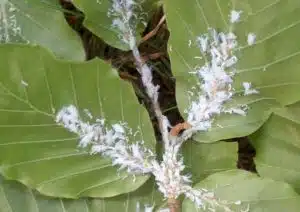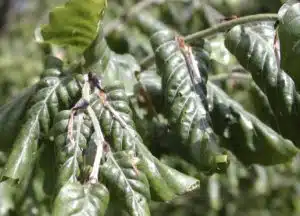HALF PRICE SALE ON EVERYTHING ENDS TONIGHT
NEW SEASON BARE ROOTS AT 50% OFF LAST SEASONS PRICES – ENDS 31 JULY
***TODAY ONLY – GET AN EXTRA 10% OFF SALE PRICES WITH CODE FLASH10***
Menu
HALF PRICE SALE ON EVERYTHING ENDS TONIGHT
NEW SEASON BARE ROOTS AT 50% OFF LAST SEASONS PRICES – ENDS 31 JULY
***TODAY ONLY – GET AN EXTRA 10% OFF SALE PRICES WITH CODE FLASH10***
You are here: Home »
Established Fagus sylvatica hedges don’t generally suffer from problems, but they can occasionally arise, we have dealt with the most common disorders here.
The new tender Spring growths of Beech hedges can be severely damaged by late Spring frosts that occur after the leaves have emerged. As Beech is quite late to come into leaf this may not be a common occurrence and a frost of this nature is likely to damage other susceptible trees and shrubs as well.

The affected growth will turn brown and shrivel very quickly after, secondary growth will then be produced a few weeks later and the hedge should recover without any lasting damage done.
This is an aphid pest specific to Beech hedges and trees, it is easy to spot as patches of white fluff on the undersides of the leaves that looks a little like cotton wool. Under this waxy covering are small pale-yellow sap feeding aphids that exude sticky, sugary honeydew that can result in a secondary infection of sooty mould growing on the sap.

Woolly aphids are usually active from leaf emergence (late April/early May) until mid summer. The eggs then lay dormant until the following Spring.

Woolly Beech aphid is not a problem on well established Beech hedges, it causes no real distress to the hedge. Furthermore, it can be very difficult to treat as the only way of controlling is with chemicals and getting full coverage is virtually impossible on a dense fully grown hedge.
On young and newly planted hedges this can however be a real problem, especially with bare root hedging plants trying to get established, it can indeed kill new plants if they are struggling. A close eye should be kept for the first couple of seasons and treated if discovered with a recommended insecticide.
Honey fungus is the common name for a notorious group of Armillaria fungi that attack the roots of established trees and shrubs by spreading through the soil and is one of the most destructive fungi in the UK. With Honey Fungus the normal symbiosis between plant and fungus (that occurs to the benefit of both organisms throughout nature) is out of balance, the fungus takes far more from the affected plant and gives little or nothing back causing affected plants to progressively weaken and become pale, making little or no new growth. The affected trees or shrubs often die in during dry hot spells or other spells of weather causing stress.
The fungus spreads through the soil by means of characteristic black ‘Bootlaces’ or rhizomorphs that can be hard to find in the soil, during the latter, more advanced stages of infection they may be found underneath the bark of infected trees and shrubs.

Affected Beech hedges will have an obvious layer of white mycelium in between the bark and inner wood of the stems (that smells strongly of mushrooms) often with obvious cracking and bleeding close to the base of the stems. Infected plant material will often produce a transient bloom of honey coloured toadstools in Autumn.
Honey fungus is a relentless killer with no methods of chemical control available at present leaving these options to deal with it